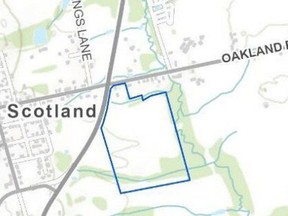
County of Brant councilors were skeptical that a 90-day extension would be enough to fix key issues with an application to build a subdivision in Scotland.
Advertisement 2
Article content
Property owner Rajan Jhamb, represented by IPS Consulting Services, is proposing 37 residential homes on a 67-acre lot in the village of Scotland, 20 kilometers southwest of Brantford.
Article content
The lot currently features a single-detached home and workshop on lands previously used for farming. In addition to woodland and vegetation, the lot is also home to parts of the lower Oakland Swamp, recognized as a provincially significant wetland.
County planner Kayla DeLeye told councilors on Jan. 9 that, as the application stands, it “does not represent sustainable development, is not good planning and is not in the public interest.”
Foremost of the key concerns is that the rural community, with a population of around 700, is not set up with municipal services, meaning each of the proposed 37 lots would be connecting on private septic and well water systems.
Advertisement 3
Article content
County of Brant environmental services staff and a hydrogeological study peer reviewer expressed concerns with this, DeLeye told The Spectator, with county staff questioning the impact it would have on the existing residents — and future expansion.
The area calls for a co-ordinated approach to servicing and overall community design, DeLeye told The Spectator, given “the large amount of land designated for future residential development, and the several large-scale plans of subdivision in the planning process,” she said.
However, concerns with the application extend beyond county staff.
The Ministry of Transportation (MTO) has jurisdiction over two of the roads bordering the proposed subdivision — Oakland Road and Highway 24 — and in the report presented to council, noted that access points suggested by the applicant fell below MTO standards.
Advertisement 4
Article content
Natural hazards provided an additional sticking point, with further floodplain analysis needed, the report said.
It also noted that the Grand River Conservation Authority (GRCA) advised that engineered fill or native undisturbed soils would be needed to support the foundations of the homes.
Existing community members expressed apprehension as well.
At a public hearing on Dec. 13, Robert Anjema told councilors he was concerned that the plan was focused on “building and selling new homes,” without much consideration for the local community.
Others pointed out that nothing in the plan addresses telecommunications — already unreliable in the area, they said — as well as the impact the subdivision could have on the local school, which is already nearing 100 per cent utilization rate.
Advertisement 5
Article content
Appearing before council remotely on Jan. 9, Kevin Bechard, a planner from IPS, asked advisors to hold off on refusing the application and instead consider a 90-day extension.
He proposed the applicant could continue to address the issues and bring them to resolution “as best we can,” Bechard said.
However, councilors were unconvinced and ultimately voted to refuse the application, meaning the applicant will now need to go through Ontario Land Tribunal or resubmit a new application, DeLeye told The Spectator.
“It’s not small things here that need to be rectified,” Coun. John Peirce said on Tuesday before the vote.
Peirce added that with “four major issues that you as the developer or proponent have failed to comply with, I’m trying to understand your optimism in resolving these issues.”
Celeste Percy-Beauregard is a Local Journalism Initiative Reporter based at the Hamilton Spectator. The initiative is funded by the Government of Canada.
Article content